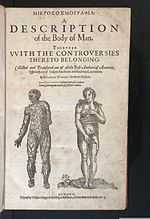Helkiah Crooke
Helkiah Crooke (1576-1648), Court physician to King James I of England, is best remembered for his textbook on anatomy, Mikrokosmographia, a Description of the Body of Man.[1] He was the first qualified doctor to be appointed Keeper of Royal Bethlem Hospital, but his conduct as Keeper was controversial and he was eventually removed from that office on the grounds of corruption and constant absenteeism.
Family
He was born in Great Waldingfield, Suffolk, third son of Thomas Crooke, rector of the parish and later reader at Gray's Inn, and his wife, whose family name was Samuel. His eldest brother Sir Thomas Crooke achieved distinction as the founder of Baltimore, County Cork.[2] Thomas and the second brother Samuel Crooke, like their father, were inclined to Calvinist views; Helkiah on the other hand is said to have leaned towards Roman Catholicism. Sir Thomas in his will of 1629 speaks with obvious affection of "dear Helkiah".[3] The brothers seem to have been rather similar in their characters: both were men of talent and energy, but both were accused of a complete lack of scruple: just as Helkiah was accused of corruption, so Thomas was accused of enriching his town of Baltimore on the profits of piracy.
Early career
He went on the Sir Henry Billingsley scholarship to St. John's College, Cambridge, graduating Bachelor of Arts in 1596;[4] then went to the University of Leiden, where he graduated as Doctor of Medicine in only a few months.[5] For some time he practiced privately in Suffolk; his first application to join the Royal College of Physicians was unsuccessful, but he was admitted in 1613 and became a fellow in 1620 and anatomy reader in 1629. Possibly through the influence of his brother Thomas, who had some acquaintance with King James I, he was appointed doctor to the Royal Household.
Mikrokosmographia
Among Helkiah's patients was William Jaggard, who later famous became as the publisher of William Shakespeare; Helkiah is said to have treated Jaggard for syphilis. It was Jaggard who in 1615 published Helkiah's best-known work, Mikrokosmographia. The book was a success, although it was caused some controversy, partly because it was written in English, and partly because it criticised the teachings of Galen. Most notably, it contained frank illustrations of the human sexual organs, leading the Church authorities to denounce it as "indecent".[6] Perhaps because of Helkiah's position at Court, the controversy did him little damage and a second edition appeared in 1631. How much of the book was original has been disputed: it has been described as a compilation, with little original observation;[7] some critics accused Helkiah of outright plagiarism.

Keeper of Bedlam
In 1619 he was appointed Keeper of Bethlem Royal Hospital, popularly known as "Bedlam", the principal London hospital for the treatment of the mentally ill; he was the first qualified doctor to hold the office, and had conducted a vigorous campaign to remove his predecessor, Thomas Jenner, due to his lack of the proper qualifications. His record here, as elsewhere, is controversial. His admirers called him a reformer who pioneered the humane treatment of the mentally ill:[8] his critics claimed that he embezzled funds and was usually absent from the Hospital, deputising his duties to his son-in-law, Thomas Bedford. Most serious was the complaint that care of patients was so neglected that many were "like to starve". Helkiah was often accused of attacking others for faults of which he was himself guilty, and his denunciation of his predecessor Jenner for incompetence was not forgotten. Complaints became so numerous that an inquiry was held in 1632 and Helkiah was removed from office; he was the last Keeper to be appointed simply on the basis of royal patronage.
Last years
The costs of defending the inquiry are said to have greatly impoverished him and in 1635 he resigned his fellowship of the College of Physicians.[9] He retired to Clerkenwell: so little is known of his last years that he is sometimes thought to have died in 1635, but there is a record of his burial at St James's Church, Clerkenwell in March 1648.
Little is known of his family except that he had a daughter, who married Thomas Bedford.
References
- ↑ Moore, Norman "Helkiah Crooke" Dictionary of National Biography 1885-1900 Vol. 13 p.205
- ↑ Ekin, Des The Stolen Village- Baltimore and the Barbary Pirates O'Brien Press Dublin 2008 p.35
- ↑ Waters, Henry Fitz-Gilbert Genealogical Gleanings in England 1901 Vol.1 p.325
- ↑ Moore p.205
- ↑ Moore p.205
- ↑ Ekin p.35
- ↑ Moore p.205
- ↑ Ekin p.35
- ↑ Moore p.205